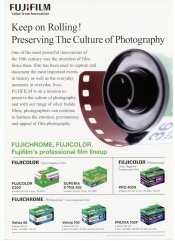Dear Mike,
I was referring to the 3-year-ago time frame suggested above.
exactly, 2-3 years ago the trend of (bigger) labs being closed phased out. But lots of big labs stayed in business (e.g. The Darkroom, Richard, Dwaynes, Photo Vision in the US; Cewe, Fuji Eurocolor, Orwonet, allcop, dplab, Photo Studio 13 and some further in Germany). And in the recent past we've seen lots of new, smaller and flexible labs, often started by young(er) film enthusiasts.
The lab situation is changing. I know of lots of labs with increasing demand. A so strong increase that even new machinery had to be installed to satisfy the demand.
And in addition to the article I've posted above:
https://www.cbc.ca/news/canada/toronto/the-rise-of-film-photography-1.4757070
No. Absolutely wrong. This "Fujifilm is exiting the film production" statement is spread by people on the internet who have absolutely no knowldege about the photo film industry. Please do yourself and your repution a favour and stop repeating this misinformation / FUD.
The facts:
1. Fujifilm is by far the world's biggest photo film manufacturer with increasing production. Mainly due to Instax instant film production, which has been for quite some time a huge global volume mass market again. Fujifilm is producing more Instax film than the
combined (added) photo film production of Fujifilm (non-instant film), Kodak, Ilford, Foma, Agfa (Belgium), Polaroid Originals, InovisCoat, Lucky, Shanghai, Tasma etc..
The instant film market is meanwhile a significantly bigger market compard to standard films. And Fujifilm with the Instax line is dominating this market (more than 96% market share). Fujifilm is producing Instax film in three shifts a day (24h) all days because of the huge and increasing demand.
In their last fiscal year (from 04/17 to 03/18) Fujifilm sold 7.7 million Instax cameras (!!). For comparison: In 2017 only 4.1 million DSLM cameras were sold, and about 7.58 million DSLRs. Fujifilm's next target for their current fiscal year is to sell 10 million Instax cameras (all confirmed last Photokina in September).
2. Fujifilm released also a commitment to standard film (non-instant) at Photokina. It was presented both big on a booth-wall together with a film showcase and large silver-halide prints from their films made on their own papers. And flyers with this statement and the current film programme were available for every booth-visitor (see the attachment, I hope the upload works). Fujifilm Germany told me they have currently backorders for several hundred thousands of film rolls, so demand is significantly surpassing supply currently. They had to significantly increase their forecasts. As Germany is mostly (very) late to trends

, it is quite likely that in further markets there is a similar or even stronger trend. All this increasing demand / forecasts is sent to the headquarter. They have to react and modify, increase the production. This clear statement is a first step.
3. Fujifilm has had the best presentation of their silver-halide products at Photokina for years: Instax was of course again huge, standard film was presented the first time since two Photokinas (see above), their silver-halide papers had a very good presentation - including its new "best-of-the-best" Maxima paper with more than 100 years lifespan. A huge focus was generally on printing photos with huge galleries not only on their huge booth, but also in other halls. Even their RA-4 minilab machines were shown on the booth.
So, Fujifilm had indeed the best presentation of traditional silver-halide products of all companies of this sector.
Fujifilm is making much more revenue (more than 1.5 billion) from their silver-halide products than Eastman Kodak, Kodak Alaris, Ilford, Foma, Polaroid Originals, InovisCoat, Bergger, Lucky, Shanghai, Tasma etc.
together.
4. Fujifilm has declared to increase their market share in the X-ray film market. This market has increasing demand from some Asian markets, especially China (because of some healthcare reforms).
Kodak and Ilford doing smaller productions and smaller producers going small, too, using remnant machines and nursing them back to utility.
These scaling down processes were done some time ago. Now with increasing demand the manufacturers sometimes even have the problem to keep up with this demand (see above). Kodak Alaris Germany also has big backorders of several hundred thousands of film (demand surpassing supply). The Ilford guys told me they also see increasing demand for their film. Same said Adox, Bergger, ars-imago, Maco and all the distributors I've talked to at Photokina. There has been the best 'mood' at this Photokina among the film companies for more than a decade. There is really something going on in the market. And this "something" is positive

.
Best regards,
Henning





 . But I agree that it is very easy with a sous vide, too.
. But I agree that it is very easy with a sous vide, too. , it is quite likely that in further markets there is a similar or even stronger trend. All this increasing demand / forecasts is sent to the headquarter. They have to react and modify, increase the production. This clear statement is a first step.
, it is quite likely that in further markets there is a similar or even stronger trend. All this increasing demand / forecasts is sent to the headquarter. They have to react and modify, increase the production. This clear statement is a first step.
